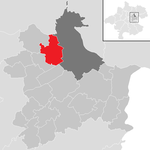Greater Linz
Groß-Linz is the name for an enlargement of the city of Linz planned from 1938, only rudimentarily realized, through the incorporation of surrounding communities. It goes back to planning by Adolf Hitler after the " Anschluss of Austria " in 1938.
The National Socialist Greater Linz
Before the “Anschluss” in 1938, Linz had around 120,000 inhabitants. The National Socialist plans envisaged an expansion of the city to up to 420,000 inhabitants, Linz was one of the five Führer cities . This was to be carried out on the one hand by setting up heavy industry ( Hermann-Göring-Werke ) and the associated housing program, on the other hand by forcibly incorporating some of the surrounding communities in Linz.
An expansion of the urban area to 400 km² was planned. In 1940, Ebelsberg, St. Magdalena, Leonding, Traun, Pasching, Asten and Puchenau as well as parts of Ansfelden, Gramastetten and Steyregg were to come to Linz in a first step, and in a second step Hörsching, St. Florian, Luftenberg and Ottensheim were to expand Parts of Gramastetten, Wilhering and the rest of Ansfeld follow. Most of the communities resisted. The incorporation of Traun and Leonding was negotiated, but was not approved by the responsible ministry.
Linz reached its current size of around 96 km² in 1939 through the completed incorporation of Ebelsberg, St. Magdalena and Keferfeld (up to 1938 it was 56 km²).
Projects implemented 1938–1945
- Forced incorporation of the communities Ebelsberg , St. Magdalena (1938) and the Leondingen district of Keferfeld (1939) to Linz
- Establishment of the Hermann Göring works and the nitrogen works
- Construction of numerous residential buildings ( Hitler buildings )
- Construction of Linz Airport in Hörsching
- Construction of the Hörsching , Ebelsberg and Auhof barracks .
- Construction of a cemetery for the future city, the Linz / St. Martin in the municipality of Traun
Unrealized plans 1938–1945
- Other incorporations, namely Leonding , Pasching , Hörsching , Traun , Ansfelden , Asten , Ottensheim , Puchenau , Lichtenberg .
- Construction of numerous splendid buildings for Linz (see Architecture in the Time of National Socialism # Linz )
- Establishment of a technical university
Planning after 1945
Up until the 1970s, serious consideration was given to incorporating Leonding into Linz. Only after Leonding's town elevation in 1975 were the plans abandoned by Linz city politicians.
In 2003, the incorporation of the neighboring communities in Linz was discussed again, corresponding plans were made and studies by Friedrich Klug were published by the magistrate.
In 2018, greater Linz was again discussed by the Mayor of Linz, Klaus Luger, and City Councilor for Planning, Markus Hein , because Linz's population is forecast to grow to over 230,000 people by 2030 and therefore building space could become scarce. This met with fierce opposition from the mayors of the affected municipalities, who - if at all - considered increased cooperation to be more sensible.
literature
- Ingo Mörth : Community identity and community awareness as a factor in possible amalgamation of communities in the Linz area. Linz 2007.
- Friedrich Klug: Solution of the city-surrounding area problem. Linz 2003: Self-published by the City of Linz a. a. (IKW series of publications on communal research in Austria, vol. 112).
- Rudolf Peter Altmüller: The Linz incorporations. A contribution to the development history of the state capital Linz. Linz 1965: Archives of the City of Linz & Trauner Verlag.
- Hanns Christian Löhr: Hitler's Linz. The "home district of the Führer". Berlin 2013, ISBN 9783861537366 .
Individual evidence
- ↑ Linz under the swastika
- ↑ The hard but ultimately futile struggle to create Greater Linz , Oberösterreichische Nachrichten, January 30, 2010.
- ↑ Linz twice as big after incorporation , Krone, April 2, 2007
- ↑ Ingo Sarlay : Hitler's Linz - Planning Centers and Planning Concepts, published in 2006 on linz09.info, accessed on npo-consulting.net on July 26, 2018.
- ↑ 1938: How "Oberdonau" was enlarged and the cities got out of hand , Oberösterreichische Nachrichten, 23 July 2018.
- ^ City of Linz, history
- ↑ Ingo Mörth : Community identity and community awareness as a factor in possible amalgamation of communities in the Linz area. Linz 2007
- ^ Neighboring communities do not want to merge into Greater Linz , OÖ Nachrichten, March 18, 2018
